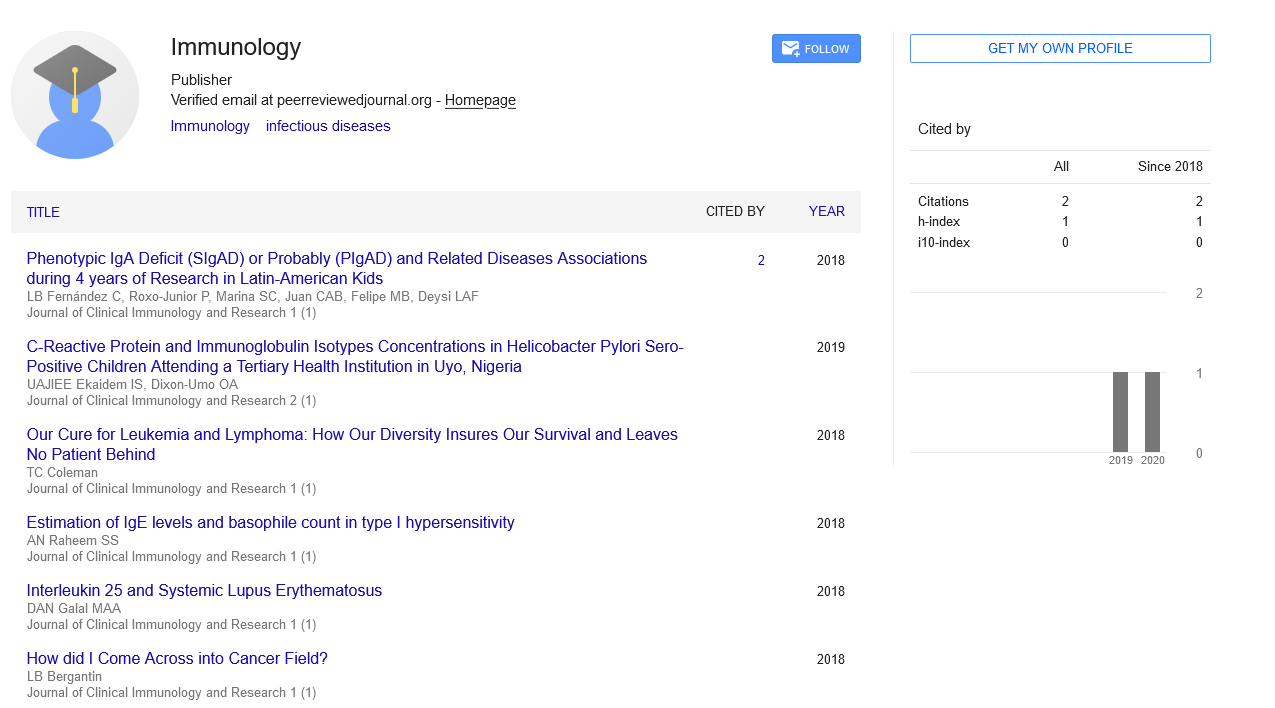Commentary, J Clin Immunol Res Vol: 4 Issue: 3
Chromosomal Primary Immunodeficiency
Jobia Alex*
Department of Gynecology, United Kingdom Metropolitan Geriatric Medical Center, UK
*Corresponding author: Jobia A, Department of Gynecology, United Kingdom, Metropolitan Geriatric Medical Center, UK; E-mail: Joal285.com
Received date: June 04, 2021; Accepted date: June 17, 2021; Published date: June 28, 2021
Keywords: Malignancies
Introduction
Chromosomal Primary Immunodeficiency Diseases presents discussions of gene identification, mutation detection, and clinical and research applications for over 100 genetic immune disorders - disorders featuring an increased susceptibility to infections and, in, certain conditions, an increased rate of malignancies and autoimmune disorders. This resource proudly documents the tremendous pace of progress in dissecting the complex immunologic networks liable for protecting individuals from these disorders. The two human immunodeficiency viruses, HIV-1 and HIV-2, are members of the family of Retroviruses, within the genus of Lent viruses. Retroviruses are found in various vertebrate species, related to a good sort of diseases, in both animals and humans. In particular, retroviruses are found to be related to malignancies, autoimmune diseases, immunodeficiency syndromes, aplastic and haemolytic anaemia’s, bone and joint disease and diseases of the systema nervosum .The many different strains of HIV-1 are separated into major (M), new (N) and outlier (O) groups, which can represent three separate zoonotic transfers from chimpanzees. Groups N and O are mainly confined to West and Central African Republic (Gabon and Cameroon), though cases of O are found world-wide thanks to international travel, after contact with infected individuals from these areas. The HIV strains in Group M are those mainly liable for the HIV/AIDS pandemic and that they are so diverse that they need been sub classified into subtypes. This huge diversity of HIV-1 is vital when diagnostic testing, treatment and monitoring are applied because the results may differ between different subtypes or clades. The diversity of HIV-2 is far less, but subtypes A-H have been proposed. Primary immunodeficiency disorders (PIDs) are a heterogeneous group of inherited disorders that affect different components of the system. There are quite 150 different disorders which are described till date. Despite major advances within the molecular characterization of PIDs over the last 20 years, many patients remain undiagnosed or are diagnosed too late with severe consequences. Recognizing different clinical manifestations of PID is that the primary most significant step. It should be followed by use of appropriate diagnostic tools from an enormous number of investigations available. This review will specialise in important presenting features of PID and laboratory approach for diagnosis of suspected cases of PID. In most cases, the investigations focus on a certain PID group according to the type of infection or disease encountered in the clinic. For example, in cases of viral and fungal infections, the efforts are directed to T cells, and in infections caused by encapsulated bacteria, B cells are implicated. In infections with certain microorganisms such as Neisseria meningitis, complement system dysfunction is implicated, whereas in Serratia and organ abscesses, an involvement of phagocytic cells, and in Herpes encephalitis, Toll-like receptor disorders are suspected. Systemic LE (SLE) and hemolytic uremic syndrome are frequently seen diseases that suggest a dysfunction of the complement system; gingivitstomatitis and abscesses imply phagocytic system disorders, and the sinopulmonary system diseases are suggestive of the humoral immune system (antibody deficiency) disorders The aetiologic agent of AIDS, the HIV virus, differs in important ways from more traditional human viral pathogens like hepatitis B, poliovirus or measles virus. HIV attacks elements of the immune system and the nervous system (brain), and results in an infection most virologists believe to be lifelong. The factors influencing the viral activity level are currently unknown, but it's clear that the virus can move readily from a resting or dormant state to intense activity. This result in a breakdown of body resistance and subsequent disease manifestations of varying the infection of sexually active women creates the problem of perinatal transmission of HIV. The likelihood that an infected mother will transmit HIV to her newborn child is estimated to be 25 to 50 per cent. Therefore, in those areas of the world where eight to ten per cent of pregnant women are infected, as many as two to five per cent of all newborn children may be infected with HIV during the perinatal period. PRIMARY immunodeficiency diseases comprise a group of disorders with defects in humoral and/or cell-mediated immunity caused by various pathophysiological mechanisms. Elucidation of the constituents and functions of the immune system has progressed at a rapid pace in recent years. This has led to an appreciation that the immune system plays an important role in oncogenesis, although the causal mechanisms are far from clearly understood. Immunosuppressed transplant recipients are known to possess a strangely high incidence of malignancy.18’2’ Among the foremost convincing evidence which mdicates an association between immunity and oncogenesis may be a dramatically increased incidence of malignant disease in the primary immunodeficiencies. T cells, B cells, and antibodies also play a crucial role in creating immunological memory: the power of the system to store information a few specific pathogen in preparation for future attacks by the same pathogen. Immunological memory is a crucial concept for the creation of vaccines, which fundamentally work by triggering an initial immune reaction that makes immunological memory without creating disease. So when an individual encounters the “real” pathogen, the immune system is already equipped with the specific machinery to protect the body
 Spanish
Spanish  Chinese
Chinese  Russian
Russian  German
German  French
French  Japanese
Japanese  Portuguese
Portuguese  Hindi
Hindi 